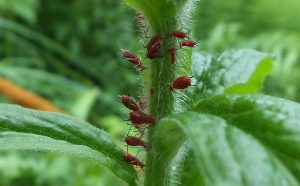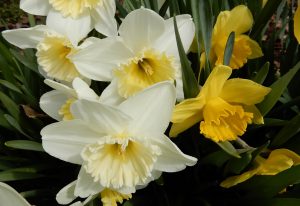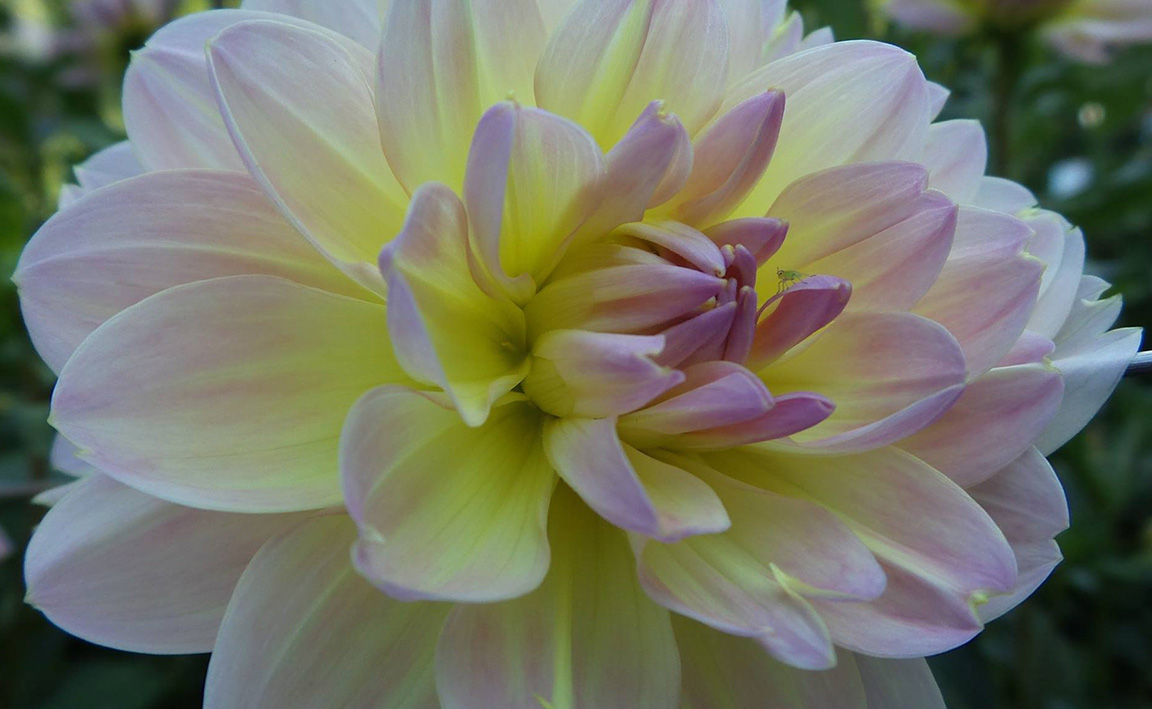
Maine Home Garden News — September 2019
- September Is the Month to . . .
- Hügelkultur: Make Beautiful Soil with Woody Debris!
- Aphids
- Daffodil Tribute: United We Bloom
- App Allows Citizen Scientists to Contribute to Monarch Butterfly Research
- Growing to Give: A Nonprofit that Grows Organic Veggies to Donate to Local Food Pantries
- Food & Nutrition: How to Turn Your Harvest into Value-Added Products to Sell
- Equal Opportunity for All Survey
September Is the Month to . . .
By Pamela Hargest, Horticulture Professional, UMaine Extension Cumberland County
- Watch the weather forecast for possible frost. Be sure to cover your tender crops as the temperature drops close to 32°F. Find out your average first frost dates using David’s Garden Freeze/Frost Dates.
- Remove plant debris from your vegetable garden. This will help prevent the spread of diseases and pests in your garden next year. As you remove plant debris, avoid leaving your garden soil bare over the winter by sowing a cover crop or mulching your garden. Sowing cover crops or mulching your garden are both a wonderful way to add organic matter and to protect your soil against erosion. For more information on cover crops and garden mulches, check out Cover Crops and Green Manures and check out Mulch, Soil, and Compost from the GardenPro Answer Book.
- Dig up tender bulbs. Tender bulbs, corms, and tubers should be dug up after their foliage dies back. It’s always a good idea to brush off excess dirt, but some plants (e.g. Dahlias) prefer to be washed before storage. Inspect for damage and pests before storage and be sure to label your bulbs well. Generally, tender bulbs can be stored in peat moss in a dark, cool location, where temperature remain above 40°F; however, some bulbs may have different temperature preferences, so be sure to do a little research before storing. For more information, check out Digging and Storing Tender Bulbs by MSU Extension and Time to Store Your Tender Bulbs by University of Minnesota Extension.
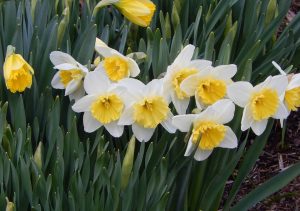 Plant Spring flowering bulbs. Spring flowering bulbs, such as daffodils, crocuses, tulips, and hyacinths can be planted in late September or October, depending on where you live. For more information, check out Planting Spring-Flowering Bulbs by Iowa State University. Consider adding daffodils to celebrate Maine Suffrage Centennial, the centennial of Maine ratifying the 19th Amendment.
Plant Spring flowering bulbs. Spring flowering bulbs, such as daffodils, crocuses, tulips, and hyacinths can be planted in late September or October, depending on where you live. For more information, check out Planting Spring-Flowering Bulbs by Iowa State University. Consider adding daffodils to celebrate Maine Suffrage Centennial, the centennial of Maine ratifying the 19th Amendment.
- Start planning for next year. The fall is a great time to use methods like sheet mulching (also known as lasagna composting) to establish new garden beds for the next year. Sheet mulching is a simple technique that involves layering different types of compostable materials in place of where your new garden bed will be. For more information on sheet mulching, see Sheet Mulching – aka Lasagna Composting by OSU Extension.
- Review the year. While the garden season is fresh in your mind, review how things went this year. Which vegetable varieties did you enjoy the most? What were your successes and failures? Did you have any disease and/or pest problems? Keep good records of your notes, so you can look back to see what has been done in the past.
- Complete a soil test. Testing your soil at least once every three years is essential, especially for annual or fruit producing crops. If your soil test results recommend lime or manure, it is best to apply these amendments in the Fall. Testing your soil in September also allows you a substantial amount of time to plan for any amendments you may add to your soil in the Spring. For more information about soil testing, check out our Bulletin #2286, Testing Your Soil and for safe manure practices, check out our Bulletin #2510, Guidelines for Using Manure on Vegetable Gardens.
- Harvest flowers and grasses for drying. Enjoy the flowers and grasses in your garden for even longer by making dried flower arrangements! Flowers and grasses can be simply air-dried by hanging them upside down in a warm, dry location for 2 to 3 weeks. Start by harvesting close to their prime and removing the foliage from the stems. Group the flowers into small bunches using twine, tying the bunches tight for they will shrink during the drying process. Keep in mind that not all flowers and grasses are meant for drying, so only use the plants that will keep their shape and color after drying. For more information, check out Drying Flowers and Foliage for Arrangements by University of Missouri Extension.
- Plant trees and shrubs. As the temperature begins to drop and rainfall often increases, it can be a great time of the year to plant any last-minute trees and shrubs. Always be sure to allow enough time between planting and when the ground typically freezes for the woody plant to get established. For more information, check out Bulletin #2366, Selecting, Planting, and Caring for Trees and Shrubs in the Maine Landscape.
- Clean and sharpen tools for next year. September is a great time of the year to prepare your tools for winter storage. It’s always a pleasant surprise when you discover your tools are all ready for you to use in the Spring. For more information, check out How to Clean and Sharpen Your Pruners by UNH Extension and Cleaning Garden Tools by University of Vermont Extension.
- Register for the Annual Obsolete Pesticide Disposal program. Please see this tip sheet (PDF) for more information. Deadline is October 5.
- Donate extra produce through the Maine Harvest for Hunger program!

Hügelkultur: Make Beautiful Soil with Woody Debris!
By Sarah Wolpow, Master Gardener Volunteer
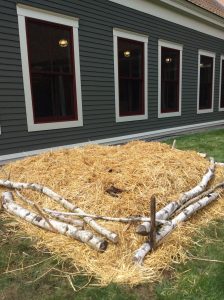
How did a group of volunteer gardeners at the Topsham Public Library grow baskets full of pumpkins on sandy soil in blasting full sun with almost no watering (in three consecutive years of drought, no less)? We built a hugel mound, that’s how!
A hugel (translated “hill” in German) mound is essentially a pile of wood (logs, branches, twigs, etc.), covered with whatever organic matter you have on hand (grass clippings, dried leaves, fresh leaves, seaweed, compost, coffee grounds, chicken coop cleanings, wood chips, etc.). In the short term, all of this layered organic matter holds moisture and nutrients and creates and excellent medium for annual plantings such as squash and sunflowers. If you’re worried about decaying wood robbing nitrogen from the soil, add some compost into your planting holes.
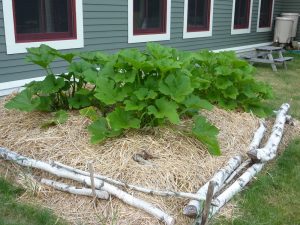
As the wood decays in the next few years, it jumps starts fungal activity, which is critical for the healthy growth of woody plants, such as shrubs and trees. Decaying wood also holds moisture like a sponge and eventually turns into a gorgeous, well-drained, biologically active substrate. A hugel mound built over large logs might not need to be watered for a decade or more. Because the mound is meant to naturally decay over time, planting trees and larger shrubs in the early stages is not recommended due to the instability of the planting area. Once the hugel mound has stabilized (i.e. the large-scale decay process has begun to slow down), larger plant material can be installed.
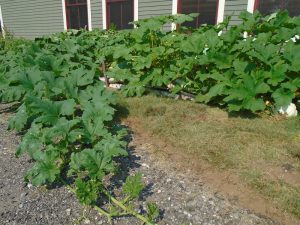
The mound we built at the library was started with partially decayed birch logs, fresh birch logs, and a wide range of organic materials, including sod from the site, leaves from the surrounding woods, and other materials that folks had to dispose of such as bunny poop and used chicken coop shavings.
At my own house on a small in-town lot, I have a “remove no organic matter from my property” mantra … to which I try to adhere (with the exception of sewage). All woody debris from pruning my various trees and shrubs gets buried in the garden or thrown in with my chickens. They poke around, rake through the branches, toss leaves and soil up over the wood, and basically build chicken hugels for me. When I need soil rich in organic matter, I pitchfork off the top layer of undecayed wood and dig out beautiful soil. It’s gardening magic that can be done with relative ease in almost any landscape!
Learn more
Aphids
By Clay Kirby, Associate Scientist, Insect Diagnostician, UMaine Extension
Aphids, sometimes called plant lice, are a large and varied group of small, soft-bodied insects. They can occur in large numbers, may appear winged or wingless, and feed by sucking sap from leaves, flower buds, and stems of a variety of plants. They may be any of a number of colors including green, pink, orange, brown, red, purple, and black. Most species have “tailpipes” (cornicles) on top of the end of the abdomen. Honeydew is excreted as a waste product of feeding. Certain aphids have a cottony white covering.
Aphids feed on practically all plants. They may be found on houseplants, flowers, trees and shrubs (conifers and deciduous), grasses, vegetables, small fruits, tree fruits, etc. Some have a narrow host range while others are not as picky.
Aphid life cycles are complex. Most spend the winter as eggs, laid during the fall by mated females. Aphids hatching from eggs are often called “stem mothers,” which give birth to live aphids without having mated. Dispersal is facilitated by the production of winged females during crowded conditions. Winged males, which develop in the fall, mate with females to produce overwintering eggs.
Aphids have piercing/sucking mouthparts that act like a straw, piercing the plant tissue and sucking out the liquid. Feeding often causes discoloration of leaves, leaf curling, wilting, and leaf drop. A heavy infestation may even kill the plant. Twigs and branches of trees may die as a result of a heavy infestation. Stunted tree growth or even death of the tree may result from prolonged or extensive infestation. Another factor to consider with aphids is their ability to spread plant diseases. A number of serious potato diseases such as leafroll and mosaic viruses are spread by aphids. Accumulations of honeydew from aphids can be a substrate for the growth of sooty mold which can discolor leaves, bark, or anything else. Lawn furniture or cars below infested trees can often be covered in hard to clean sticky honeydew.
There are cases of mutually beneficial (symbiotic) relationships between aphids and certain species of ants. The ants benefit from a steady source of food (honeydew from the aphids) and the advantages to the aphids include transportation to their host plants and protection from predators.
Many aphid infestations can be suppressed simply by washing the aphids off the plants with a hose. Other low-toxic management options include the use of insecticidal soap or horticultural oil. Avoid applying soaps and oils during the hot, sunny part of the day, as leaf burning may occur. For greenhouse growers choosing biological control to manage aphids, aphid species identification is key in deciding which parasitoids to use. Aphids needing identification can be dropped off at a local UMaine Extension office or sent directly to our diagnostic lab.
Daffodil Tribute: United We Bloom
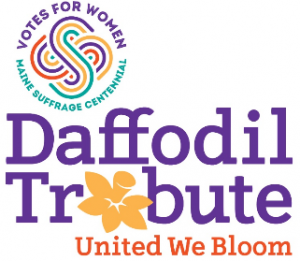 Over 100 years ago, Maine suffragists chose the jonquil (daffodil) as their flower symbol. Bouquets of daffodils graced suffrage teas and mass meetings, and at hearings in Augusta supportive legislators wore them in their lapels.
Over 100 years ago, Maine suffragists chose the jonquil (daffodil) as their flower symbol. Bouquets of daffodils graced suffrage teas and mass meetings, and at hearings in Augusta supportive legislators wore them in their lapels.
To commemorate the 100-year anniversary of Maine ratifying the 19th Amendment (which in 2019 coincidentally falls on November 5, election day!), the Maine Suffrage Centennial Collaborative invites people across the state to plant daffodil bulbs this fall.
Artists can create something daffodil-inspired, either as a stand-alone project or in collaboration with a local gardening effort.
Libraries, schools, cities and towns, businesses, garden clubs, landscapers, backyard gardeners, and anyone else can join in the fun!
Next spring, and for years to come, these beautiful flowers will blanket parks, gardens, window boxes, roadsides and outdoor spaces across the state to remind us of the suffrage centennial.
Help Maine bloom in our ongoing work for equality. Learn more and get involved at Maine Suffrage Centennial.
“What I can do – I will – Though it be little as a Daffodil” –Emily Dickinson
Using Flowers as Symbols in the Suffrage Campaign
In March 1915, following (yet another) unsuccessful effort to persuade the Maine legislature to approve a statewide referendum for full suffrage, there was an exchange of poetry in a Portland newspaper. The following poem, signed only “B,” was sent by an anti to local newspapers, and started off the exchange:
The Jonquil and the Rose
They tell a tale of suffrage
In the good old state of Maine
That is full of lively interest
And proves the men still sane.
They tell that at the “Hearing,”
And sometimes since the close,
They have worn the lady’s jonquil,
But—they’ve voted for the Rose.
Some say that men are foolish,
“The Creator made them so
To match up with the women”;
But we doubt if it is true!
You see, while smiling blandly
And politely keeping pose,
They’ve been buttonholed with jonquils
But—they’ve voted for the Rose.
Most men are fond of flowers
But in preference draw no line,
To them the jonquil’s “beautiful,”
And the red, red rose is fine.
And so it can’t be prejudice
But conviction—made them choose.
They’ve worn the lady’s jonquil,
But—they’ve voted for the Rose.
Those ladies who have spent much time
Around the statehouse dome,
Must now feel somewhat weary,
And may rest awhile at home.
Poor statesmen, nagged and badgered!
You have earned a long repose.
You have worn the lady’s jonquil,
But—you’ve voted for the Rose.
The response was written by Florence Brooks Whitehouse, a suffrage leader who lived in Portland at 42 Deering Street.
The Jonquil and the Rose (A Reply)
We have noticed in your columns
A most elucidating rhyme
Which must have kept the perpetrator
Working overtime.
It tells how at the Hearing
Which has just come to a close,
The “voters wore the Jonquil
While they voted for the Rose.”
This is pretty propaganda
And though it isn’t true to facts,
It shows the Anti-spirit
Embodied in their “tracts.”
To score a point against us
For applause of fickle hands,
They stoop to write their arguments
On running, shifting sands.
The truth about the question
Is really quite immense
For only nine and fifty
Voters proved their lack of sense
By voting down the suffrage.
And 88 men chose
To wear the Suffrage Jonquil
While voting DOWN the Rose.
In all we had a surplus
Of fifty votes to spare
If we count the House and Senate
And our friends who stood firm there.
And while the Antis seem so joyous
That we hadn’t two to one
They can’t escape the knowledge
That we won at fifty-one.
We are proud to cede the Antis
The nine disloyal “reps”
Who renounced their party pledges
To aid the Suffragettes
And the Democrats, from the cities,
Which stand for rum and booze,
We also state, quite frankly,
We are honored, them to lose.
With the Senate six and twenty
And the House four score and eight,
We had a big majority
From those who legislate.
And in 1916 surely,
We will bring the war to close,
With the whole House wearing Jonquils
While Voting DOWN the Rose.
App Allows Citizen Scientists to Contribute to Monarch Butterfly Research
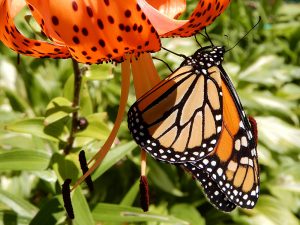 When spotting a butterfly, a common reaction may be to whip out a phone and snap a photo. A team of University of Maine researchers is hoping another response could be to use the phone to log details about areas where butterflies are likely to be found.
When spotting a butterfly, a common reaction may be to whip out a phone and snap a photo. A team of University of Maine researchers is hoping another response could be to use the phone to log details about areas where butterflies are likely to be found.
Using a mobile app, anyone can become a citizen scientist by visiting potential monarch butterfly roosting sites from Maine to Georgia and answering questions based on their observations.
Brandon Boxler, who is pursuing a master’s degree in ecology and environmental sciences, and Cynthia Loftin, associate professor of wildlife ecology and leader of the United States Geological Survey Maine Cooperative Fish and Wildlife Research Unit, plan to use data collected from the app to validate a model that predicts the location of monarch roosting sites.
“We are trying to create a model that predicts areas that have a high suitability for monarchs for roosting during their fall migration to Mexico,” Boxler says. “Although we have developed an initial model, without ground truthing, it will be hard to know the validity of the results. This application will assist us in testing and refining the model.”
The monarch butterfly conducts one of the most dramatic migrations in the world, according to the researchers. Every fall, the great-great-grandchildren of butterflies who came north from Mexico in the spring turn south and begin a 3,000-mile journey to their overwintering grounds.
However, the number of monarchs completing the migration has fallen by 90 percent in the past two decades, the researchers say.
“The monarch migration is declining because the overall number of monarchs is declining,” says Boxler, who adds there are many causes for the decline, including loss of overwintering habitat due to logging, loss of breeding habitat — native milkweed — to herbicides, as well as exposure to pesticides, disease, and parasites/parasitoids.
Researchers around the country, including Boxler and Loftin, are learning more about the monarch and its behavior in an attempt to curb the population decline.
While migrating in the fall, monarchs rest at night, often in groups of several hundred or thousand. Tens of thousands of monarchs can cluster on one tree, according to the U.S. Forest Service.
Boxler and Loftin completed a model that seeks to determine where the roosts occur and the factors common among the sites. The model suggests the butterflies tend to roost in vegetation, often in trees or bushes in otherwise open areas. They are more likely to be found near open water, and in areas with fall blooming flowers from which they can feed.
Due to the large area the model covers, it is not feasible for the researchers to ground truth, or confirm, the findings themselves.
The Monarch Model Validator, which is a survey within the Collector for ArcGIS app, was created by a former UMaine master’s student, Drew Rosebush. In spring 2018, Rosebush took a geographic information system (GIS) class taught by Kate Beard-Tisdale, a professor of spatial information science and engineering. He and three other students helped Boxler and Loftin get the app development underway as a project in the class, according to Loftin.
Users of the app may visit a predetermined high-priority site indicated by a pin on a digital map or a location of their own. While there, they are asked to answer a short survey and upload photos.
Responses are compiled in an online database the researchers will access to determine how the information compares to predictions made by their original model.
The project is funded by UMaine and the Maine Department of Inland Fisheries and Wildlife through the cooperative agreement with the USGS Maine Cooperative Fish and Wildlife Research Unit, with additional funds from the United States Department of Veterans Affairs.
More information about the project, including instructions on how to download the app, is online. Questions can be emailed to monarch-model-group@maine.edu.
Contact: Elyse Catalina, 581.3747, elyse.catalina@maine.edu
Growing to Give: A Nonprofit that Grows Organic Veggies to Donate to Local Food Pantries
By Sandi Konta, Growing to Give
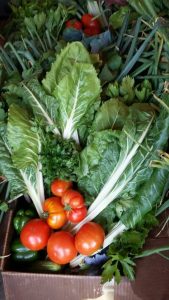
One in seven people in Maine doesn’t know where their next meal is coming from. For those experiencing food insecurity, fresh, nutrient-rich food is often out of reach. Growing to Give was created to make locally-grown, organic vegetables more accessible to people who need them.
Based in Brunswick on Scatter Good Farm, Growing to Give is a nonprofit organization founded in 2017 with a mission to grow organic vegetables using climate-friendly methods and donate them to local people struggling with food insecurity through partner food pantries in Brunswick, Bath, Lisbon, Durham, Freeport, Harpswell, and Topsham.
To date, Growing to Give has grown and donated more than 25,000 pounds of fresh, certified-organic vegetables to local food access programs.
New volunteers are always welcome. Come connect with the earth, become part of the Growing to Give farm crew, and make a difference in your community:
Benefits for volunteers
- Convenient hours. Volunteer when it works for you!
- Children are welcome. We love it when families come to volunteer at the farm. There is always something to do.
- Learn while you volunteer. Interested in learning more about organic gardening and climate-friendly farming practices? Join us!
- Community. Come meet like-minded people who share your values.
- Easy to sign up. To join in the fun, click Growing to Give Volunteer Form.
To learn more about Growing to Give, check out our website, Instagram, and Facebook.
The Maine Master Gardener Development Board supports this project and numerous other volunteer projects throughout the state. Please consider making a contribution today!
Food & Nutrition: How to Turn Your Harvest into Value-Added Products to Sell
By Beth Calder, Extension Food Science Specialist & Associate Professor, UMaine Extension
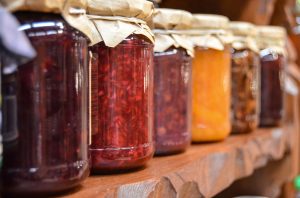 Harvest season is here again. If you preserve or produce a food product that your family and friends rave about, have you thought of turning those favorites into a side business and wondered about the process of starting a small, home-based food business? It’s inexpensive and probably easier than you think!
Harvest season is here again. If you preserve or produce a food product that your family and friends rave about, have you thought of turning those favorites into a side business and wondered about the process of starting a small, home-based food business? It’s inexpensive and probably easier than you think!
You must submit an application to the Maine Dept. of Agriculture, Conservation & Forestry to obtain a home food processor license (for non-perishable food products): Consumer Food Inspection, for a fee of $20.00. If you are on well water, you will also need to send a water sample for a simple water quality test (coliforms, nitrates, nitrites): Water Test. Your inspector will be looking to be sure all potential food contact surfaces are easy to clean. Good news for pet lovers: you can have pets and still obtain a home food processors license. You just need to show that you can place the pets in another area of your house and that you clean your area before processing food products.
With the exception of berry-based jams, all canned food products must be tested through UMaine Cooperative Extension’s Food Testing Services to ensure the safety of the package, heating process, and pH/water activity levels. For more information, see Food Testing Services. For plain, berry-based jams and jellies, UMaine Cooperative Extension recommends that you follow a published Ball recipe, using their water bath processing temperature and time as well as following the head space and jar size recommendations in the recipe.
If you would like more information on this topic, University of Maine Cooperative Extension offers a helpful online fact sheet called Recipe to Market – How to Start a Maine Food business. This fact sheet has additional information, such as how to purchase a pH meter, what is allowed to be produced under a home food processor license and other additional resources.
If you have other questions, are interested in producing other types of canned food products, or would like to attend an in-person workshop on how to start a food business in Maine; please contact Beth Calder at 207.581.2791 or beth.calder@maine.edu.
Equal Opportunity for All
Thank you for choosing Maine Cooperative Extension for your educational needs. It is important that we ensure equal opportunity to all who might benefit from our programs and resources. As a way to document those we are reaching through Maine Home Garden News, we are seeking the following information on an optional and anonymous basis.
University of Maine Cooperative Extension’s Maine Home Garden News is designed to equip home gardeners with practical, timely information.
Let us know if you would like to be notified when new issues are posted. To receive e-mail notifications fill out our online form.
For more information or questions, contact Kate Garland at katherine.garland@maine.edu or 1.800.287.1485 (in Maine).
Visit our Archives to see past issues.
Maine Home Garden News was created in response to a continued increase in requests for information on gardening and includes timely and seasonal tips, as well as research-based articles on all aspects of gardening. Articles are written by UMaine Extension specialists, educators, and horticulture professionals, as well as Master Gardener Volunteers from around Maine, with Katherine Garland, UMaine Extension Horticulturalist in Penobscot County, serving as editor.
Information in this publication is provided purely for educational purposes. No responsibility is assumed for any problems associated with the use of products or services mentioned. No endorsement of products or companies is intended, nor is criticism of unnamed products or companies implied.
© 2019
Call 800.287.0274 (in Maine), or 207.581.3188, for information on publications and program offerings from University of Maine Cooperative Extension, or visit extension.umaine.edu.
The University of Maine is an EEO/AA employer, and does not discriminate on the grounds of race, color, religion, sex, sexual orientation, transgender status, gender expression, national origin, citizenship status, age, disability, genetic information or veteran’s status in employment, education, and all other programs and activities. The following person has been designated to handle inquiries regarding non-discrimination policies: Director of Equal Opportunity, 101 North Stevens Hall, University of Maine, Orono, ME 04469-5754, 207.581.1226, TTY 711 (Maine Relay System).

